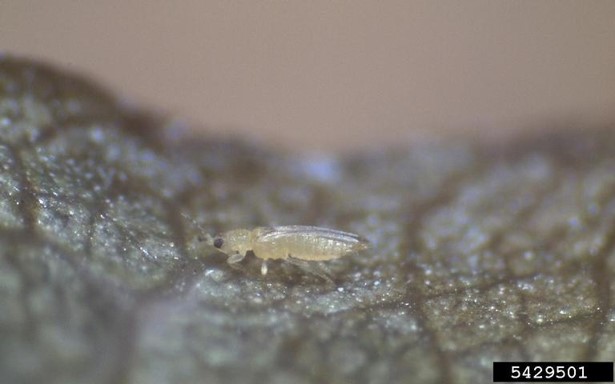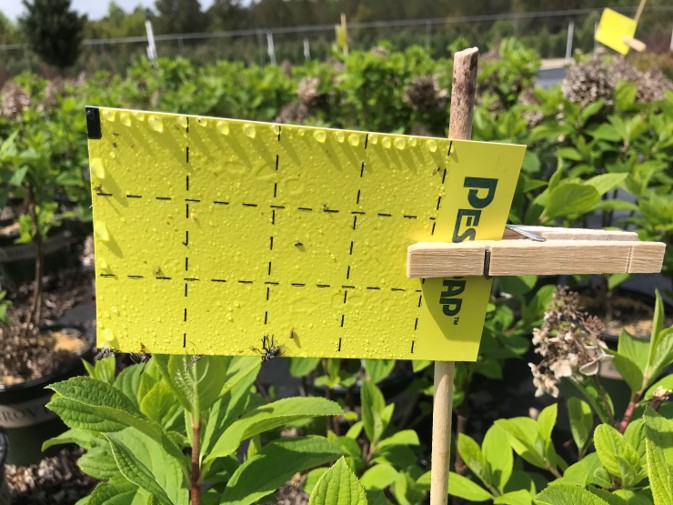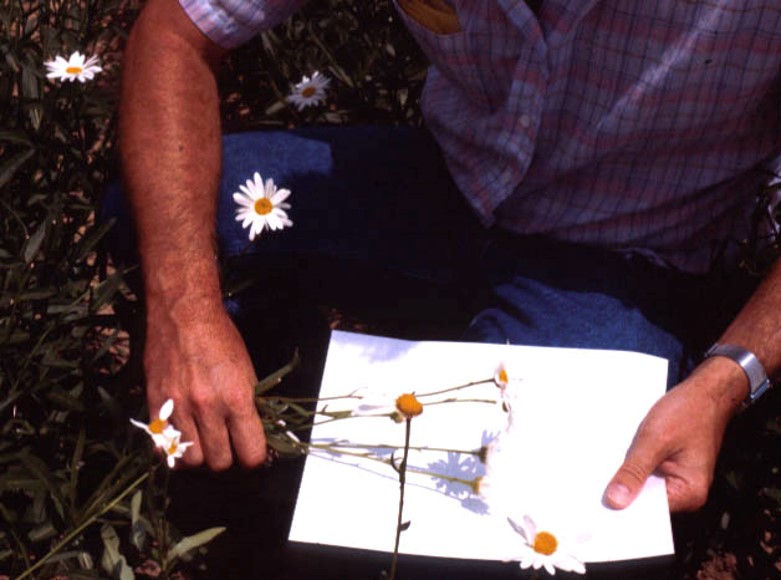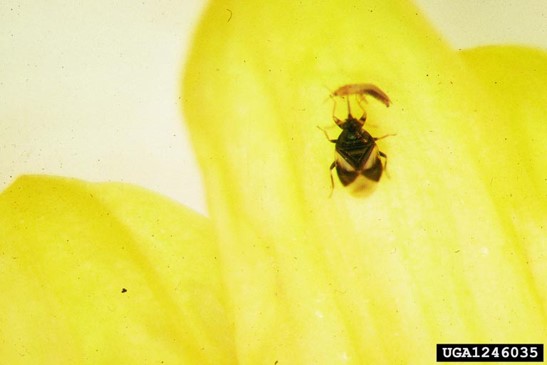Chilli thrips, Scirtothrips dorsalis (Fig. 1) is a recently invasive thrips species in the United States. Currently, chilli thrips infest more than 150 crops worldwide including strawberries, cotton, tea, citrus, and peppers as well as many ornamental plants. The pest has become increasingly problematic in nurseries because of its wide host range, small size, rapid reproduction and development. Chilli thrips quickly adapt in a new region. Chilli thrips was first noticed in the United States in Florida in 1991 but did not immediately establish. In 2005, they were observed on roses in Florida. The pest is also established in Hawaii and throughout the Caribbean Islands. In Georgia, chilli thrips was first reported in 2007.

Identification and biology
Chilli thrips is small, about 2 mm in length. It has a pale-yellow body with a pair of darker wings. The antennae have eight segments with alternating patterns of dark and pale yellow. Chilli thrips lay eggs inside of plant tissue that is above the soil. The eggs hatch in about 6 to 8 days in summer months. Newly hatched larvae go through two larval stages within a week. Chilli thrips larvae colonize and feed on newly developing shoots. After the larval stages,they molt into a prepupal stage for about a day followed by a pupal stage for about three days. The pre-pupal and pupal stages are inactive stages and they do not feed on plants. Chilli thrips pupae are found in cracks and crevices on the plant or leaf litter. They are rarely found on the potting soil media. A female chilli thrips produces about 60 to 200 eggs in her lifetime. The lifecycle can last from 14 to 20 days from egg to adult.
Host plants
Chilli thrips are serious pests of different plants in different regions of the world. In Asia, chili pepper crops on the Indian subcontinent, tea and citrus in Japan, as well as sacred lotus in Thailand are consistently attacked by chilli thrips. Other major economic hosts include banana, cocoa, corn, cotton, grapes, kiwi, melon, peanut, pepper, strawberry, and roses. Recently added hosts are avocado, cashew nuts, canistel, dragon fruit, miracle fruit, sapodilla, guava, litchi and mango. This shows that its host range is expanding as this pest is exposed to new plant species in new region. The main wild hosts are Acacia, Brownea, Mimosa and Saraca.


Monitoring and management
Monitoring for the early incidence of chilli thrips on the plants is the key. Chilli thrips are attracted to yellow sticky traps (Fig. 2). The sticky traps should be monitored and replaced every seven to 10 days. Beating the plant branches over white paper or fabric would also help to determine if there is an active population of chilli thrips (Fig. 3). Once thrips are found, it is critical to identify the thrips because there are other species of thrips found on the same types of plants such as western flower thrips or greenhouse thrips. Removal of weeds around infested plants can help lower population size of thrips.
Biological control can be an effective way to reduce chilli thrips populations. Effective natural enemies include the minute pirate bug, Orius laevigatus as well as the lady bird beetles. There are also several commercially available mite species such as Amblyseius degenerans, Amblyseius cucumeris and Amblyseius swirskii as well as a nematode, Steinernema feltiae that have been shown to reduce chilli thrips population on plants. Insecticides are also available and effective for control. Please contact your local UGA Extension agent for latest insecticide recommendations.

References
Arthurs, S., C. L. Mckenzie, J. Chen, M. Dogramaci, M. Brennan, K. Houben and L. Osborne. 2009. Evaluation of Neoseiulus cucumeris and Amblyseius swirskii (Acari: Phytoseiidae) as biological control agents of chilli thrips, Scirtothrips dorsalis (Thysanoptera: Thripidae) on pepper. Biological Control, 49: 91–96.
Chen, Y., S. Arthurs and D. Ring. 2016. Chilli thrips control, identification and management. Retrieved from https://www.lsuagcenter.com/profiles/lbenedict/articles/page1469030428468
Degenerans-System. (n.d.). Retrieved from https://www.biobestgroup.com/en/biobest/products/biological-pest-control-4463/beneficial-insects-and-mites-4479/degenerans-system-4646/
Diffie S; Srinivasan R, 2010. Occurrence of Leucothrips furcatus, Scirtothrips dorsalis, and Tenothrips frici (Thysanoptera: Thripidae) previously unreported from Georgia. Journal of Entomological Science, 45: 394-396.
Kumar, V., G. Kakkar, C. L.McKenzie, D. R. Seal and L. S. Osborne. 2013. An overview of chilli thrips, Scirtothrips dorsalis (Thysanoptera: Thripidae) biology, distribution and management. Weed and Pest Control – Conventional and New Challenges. doi: 10.5772/55045
Kumar, V., D. R. Seal, G. Kakkar, C. L. Mckenzie, and L. S. Osborne. 2012. New tropical fruit hosts of Scirtothrips dorsalis (Thysanoptera: Thripidae) and its relative abundance on them in South Florida. Florida Entomologist, 95: 205–207.
Ludwig, S, L. Osborne, M. Ciomperlik, and G. Hodges. (2007. Chilli thrips, Scirtothrips dorsalis Hood. National Pest Alert http://www.ncipmc.org/alerts/chilithrips.cfm.
Sangle, P. M., and D. M. Korat. 2018. Impact of pesticidal sprays in reducing sucking pests population on chilli. International Journal of Current Microbiology and Applied Sciences, (6), 478–486.
Simisky, T., R. Norton and V. Kumar. 2017. Chilli thrips. UMass Extension.